A new analysis forces paleontologists to rethink decades of T. rex research.
Others are reading now
The scientific community has made a discovery that may rewrite decades of research into the most famous predator to ever walk the Earth: Tyrannosaurus rex.
A new study published by researchers at North Carolina State University claims that many fossils previously believed to be juvenile T. rexes actually belong to a completely different species—Nanotyrannus lancensis.
The breakthrough comes from a unique fossil find known as the Dueling Dinosaurs—a perfectly preserved scene showing a small predatory dinosaur locked in battle with a triceratops.
Scientists Lindsay Zanno and James Napoli examined the smaller dinosaur bone by bone and discovered that it wasn’t a young T. rex at all, but a fully grown adult of another species.
“Turns decades of research on its head”
“This fossil turns decades of research on its head,” said Zanno, as cited by NCSU News.
Also read
Key clues came from growth rings in the bones and signs of maturity such as fused vertebrae. The animal, around 20 years old, was light and fast, weighing only 700 kilograms—nowhere near the 8-ton size of a mature T. rex.
Nanotyrannus also had unique traits: more teeth, longer arms, a shorter tail, and a differently shaped skull.
“For Nanotyrannus to be a juvenile T. rex would mean breaking everything we know about how vertebrates grow,” Napoli explained.
The discovery has major consequences.
Dozens, perhaps hundreds, of fossils used to understand how T. rex developed from juvenile to adult may now be wrongly classified. Scientists must now revisit and reclassify these specimens.
Also read
Even more striking, the study identified a second species—Nanotyrannus lethaeus—suggesting an entire ecosystem of predators existed alongside T. rex, rather than just one dominant king.
This article is made and published by Camilla Jessen, who may have used AI in the preparation


